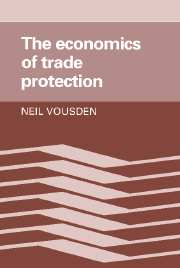Book contents
6 - Oligopoly
Published online by Cambridge University Press: 18 December 2009
Summary
Although the model of monopoly in the previous chapter is a useful starting point, many of the more interesting questions in the protection debate are better addressed using a model with more than one firm. Accordingly, we now consider the case of oligopoly. Oligopoly is a difficult industrial structure to analyse, primarily because the number of firms is small enough for strategic interactions between them to matter, and it is incumbent upon the theorist to make some assumption (which may be quite arbitrary) about the nature of these interactions. Such difficulties do not arise when an industry consists of a single firm because there are no interactions to consider (with the possible exception of behavior to deter entry), whereas under perfect competition and monopolistic competition (see Chapter 7), the number of firms is sufficiently large for the interactions among them to be insignificant. Nevertheless, many protected industries (e.g. steel and automobiles) do consist of a small number of firms, and the issues raised by the possibility of strategic behaviour are important. Indeed, many of the recent developments in the theory of protection have focused on the strategic interactions between large domestic and foreign firms. In this chapter we consider some of these issues and their implications for policy.
The literature on trade and oligopoly has been something of a growth area in recent years, and many aspects of it will not be satisfactorily resolved for some time.
- Type
- Chapter
- Information
- The Economics of Trade Protection , pp. 127 - 150Publisher: Cambridge University PressPrint publication year: 1990

